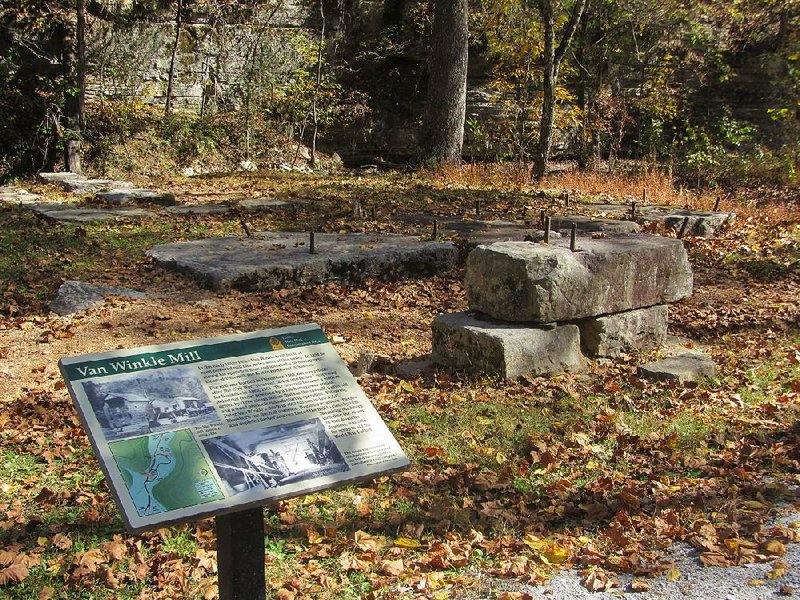HOBBS STATE PARK-CONSERVATION AREA -- Not all the ghosts in Arkansas haunt old hotels like the Crescent in Eureka Springs. Travelers attuned to history can also pick up the aura of the departed in some state parks.
The ghosts in Hobbs State Park-Conservation Area go back to an era beginning in the mid-19th century, when the timber industry cut wide swaths across Arkansas. These specters of bygone life are evoked most keenly on Historic Van Winkle Trail.
Hobbs bears the hyphenated title because it is managed jointly by Arkansas State Parks, Arkansas Natural Heritage Commission and Arkansas Game and Fish Commission. The heirs of its last private owner, lumberman Roscoe Hobbs, sold the land in 1979 to the Nature Conservancy. The state bought it later that year, and the park acquired its present name in 2002.
Historic Van Winkle Trail, a mostly level half-mile path, is named for Peter Van Winkle. He moved from Fayetteville to Benton County in 1851, initially setting up an oxen-driven sawmill. In 1858, he built the first steam-powered sawmill in Northwest Arkansas along Little Clifty Creek.
As is the case with most ghosts, an active imagination helps in picturing the past along the trail through Van Winkle Hollow, where foundations are about all that remains from the busy sawmill times. A dozen signs, some including vintage photographs, bring the history into sharper focus.
"This narrow hollow was home to one of the most important sawmill operations of 19th-century Arkansas," according to the first sign. "The mill was built, destroyed [by Confederate sympathizers in 1863] and rebuilt. The people had vision, a work ethic and loyalty. Here you will find both the wealthy and the poor; some were enslaved, then free. All faced adversity, but left a story of perseverance, leadership and success."
The valley "held more than a mill. This was a complete community that included the large saw and gristmill operations, a blacksmith shop and related industrial facilities, Van Winkle's garden and home, and homes for many of the workers and slaves, later free blacks. The combination of people and facilities helped make this area the dominant lumber producer for Northwest Arkansas."
Van Winkle spent the Civil War in Texas. He returned and rebuilt the mill in 1866, followed by the family home in 1872. One marker describes the elevated flower garden whose stairs aligned with the brick walkway of the home, creating a picturesque view from the second-floor porch.
Before the mill closed in 1890, it was the lumber source for many of the Victorian-period houses still standing in the area, as well as the cherished Old Main building at the University of Arkansas at Fayetteville. After Van Winkle's death, his heirs lost the land through bankruptcy.
Along with the history, Hobbs offers an array of outdoor activities, from staid to vigorous. It is Arkansas' largest state park in terms of land area, covering 19 square miles in parts of three counties.
The shortest of six hiking routes, Ozark Plateau Trail's inner loop, runs a mere quarter-mile while crossing a dry ridge and skirting two moist hollows. The longest, 24-mile Hidden Diversity Multi-Use Trail, rises as much as 300 feet from its starting point. It is designed for horseback riding and mountain biking as well as hiking.
Opened six years ago, the spacious visitor center features interactive exhibits for adults and children. There's a shooting range with targets placed from 25 to 100 yards. And Hobbs is the only state park where hunting is permitted, on a limited basis -- for deer, wild turkey and small game.
Just to the park's south, War Eagle Mill still grinds grains. The present structure, built in 1970, is the fourth mill at the site on War Eagle Creek. The first was constructed in 1832, four years before Arkansas became a state. More ghosts of the past may be lurking here, for visitors inclined to discern them.
To reach Hobbs State Park-Conservation Area from Rogers, take Arkansas 12 east 10 miles to the park's western boundary. It is 21 miles west from Eureka Springs via Arkansas 23 and Arkansas 12 to the park's eastern boundary.
The park's visitor center is open daily 8 a.m.-5 p.m. Admission is free. For more information, call (479) 789-5000 or visit ArkansasStateParks.com.
Weekend on 10/29/2015
